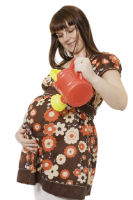Make Labor Easier by Giving Birth in Water
Some hospital maternity suites and birth centers have jacuzzi-sized labor tubs to help women giving birth in water. If the hospital of your choice does not offer one, ask for it. This is just one more way in which women can influence how birth business is done. An alternative is to rent one; check with local midwives or childbirth organizations for information.
 The tub should be large enough to bring out the mermaid in you – at least 5.5 feet wide. It’s not only giving birth in water that eases the discomforts of labor; it’s the freedom to move that gives you the greatest benefit.
The tub should be large enough to bring out the mermaid in you – at least 5.5 feet wide. It’s not only giving birth in water that eases the discomforts of labor; it’s the freedom to move that gives you the greatest benefit.
Make Yourself Comfortable
Have the water at bath-water temperature, which is usually around your body temperature. Try lounging on your back or side, or kneeling forward on all fours so that the water covers your uterus, at least up to your nipple line.
Enter the tub when the intensity of your contractions tells you that you need some relief. For most women the best time to take the plunge is between 5 and 8 centimeters dilatation, when active labor is in full swing.
You may also find giving birth in water especially comforting during transition – the most intense stage of labor. The freestyle movements of mother help baby to find the path of least resistance (and least pain). Lying in a labor tub can also be used to accelerate a slow labor.
The splashing of the water on your nipples can trigger the release of contraction-stimulating hormones. And giving birth in water is very effective in easing a fast-and-heavy labor, where the contractions threaten to overwhelm you.
When to Get Out of the Tub
If your labor stalls while you are comfortably floating in the water, get out and walk or squat on land to get your labor going again; re-enter the tub once labor gets going. Be sure to enter and exit the water between contractions and with assistance, so you don’t slip.
When you feel the urge to push, it’s time to get dry. (Babies have been born into the water when there was suddenly no time to exit or because a mother was so comfortable she could not bring herself to leave the water. Babies do just fine, as long as they are lifted up out of the water and placed in mother’s arms without delay. Baby simply goes from water to water and doesn’t take a breath until his face meets the air.)
It’s Safe to Stay in the Water
Unless your birth attendant advises you otherwise, giving birth in water is safe even after your membranes have ruptured. That’s when contractions usually get more intense and you really need the relief of water. Maternity centers with much experience with women giving birth in water report no increased rate of infection in women using water after their membranes have ruptured, as long as the mothers are in active labor and proper infection control hygiene is followed.
It is rarely necessary to leave the water for routine tests. If you need an I. V., a heparin-lock can be used in the veins of your hand, covered with a waterproof plastic bag, and sealed with a rubber band.
If intermittent fetal monitoring is necessary, let it be done on a part of your abdomen that you can lift above the water; place a plastic bag over the handheld monitor if you aren’t using monitors designed for underwater use.
If You Can’t Find a Labor Tub
If your hospital or birth center does not offer a labor tub or you’re unable to rent one, at least try sitting in a regular tub or taking a shower. A jet of warm water is often especially effective in easing back labor. Don’t expect all the pain of labor to float away into the water.
Yet our personal experience and that of other women has shown that giving birth in water is one of the most wonderful labor saving devices available.
Water Labor makes Giving Birth Easier
Remember your high school physics, place an object in water and the force of buoyancy equal to its weight lifts it up. To simplify Archimedes’ principle, let’s put it this way; water labor gives a mother giving birth a lift.
 Buoyancy feels like weightlessness. With less weight to support and less muscle tension, your body feels less pain and saves energy for where it is needed – your hardworking uterus.
Buoyancy feels like weightlessness. With less weight to support and less muscle tension, your body feels less pain and saves energy for where it is needed – your hardworking uterus.
1. Water Relieves
Muscles that weigh less get less tired and hurt less. Also, the counter pressure of water can ease the pain of sore muscles, especially during back labor. When you fill your nervous system with pleasant sensations there is less room for unpleasant ones.
Being in water is like a continuous body massage, stimulating all the touch receptors in the skin. It would take thousands of gentle fingertips to touch as many skin receptors as the water does when you soak in a nice warm bath.
2. Water Relaxes
Immersing most of your body in a warm tub soothes your mind and body, reduces stress hormones and allows your body’s natural relaxing and pain-relieving hormones to take over.
3. Water Releases
Changing positions and going with the flow of labor are the most important natural pain relievers and labor enhancers a woman can use. Water labor lets this happen more naturally and easily. Many women laboring on terra firma describe feeling rooted to one spot, afraid to move at all, lest it hurt more.
A woman in water labor is free to float with her body supported until she finds the position that best eases her discomfort. Being in water also seems to free her mind, so she can tap into her deepest instincts and let tension float away.
Next time you’re in a swimming pool see if this doesn’t ring true. Notice how you are free to move your body and clear your mind.

